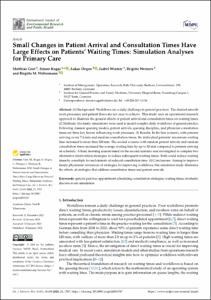Grot, Matthias; Kugai, Simon; Degen, Lukas; Wiemer, Isabel; Werners, Brigitte; Weltermann, Birgitta: Small Changes in Patient Arrival and Consultation Times Have Large Effects on Patients' Waiting Times : Simulation Analyses for Primary Care. In: International Journal of Environmental Research and Public Health. 2023, vol. 20, iss. 3, 1-11.
Online-Ausgabe in bonndoc: https://hdl.handle.net/20.500.11811/10798
Online-Ausgabe in bonndoc: https://hdl.handle.net/20.500.11811/10798
@article{handle:20.500.11811/10798,
author = {{Matthias Grot} and {Simon Kugai} and {Lukas Degen} and {Isabel Wiemer} and {Brigitte Werners} and {Birgitta Weltermann}},
title = {Small Changes in Patient Arrival and Consultation Times Have Large Effects on Patients' Waiting Times : Simulation Analyses for Primary Care},
publisher = {MDPI},
year = 2023,
month = jan,
journal = {International Journal of Environmental Research and Public Health},
volume = 2023, vol. 20,
number = iss. 3,
pages = 1--11,
note = {(1) Background: Workflows are a daily challenge in general practices. The desired smooth work processes and patient flows are not easy to achieve. This study uses an operational research approach to illustrate the general effects of patient arrival and consultation times on waiting times. (2) Methods: Stochastic simulations were used to model complex daily workflows of general practice. Following classical queuing models, patient arrivals, queuing discipline, and physician consultation times are three key factors influencing work processes. (3) Results: In the first scenario, with patients arriving every 7.6 min and random consultation times, the individual patients’ maximum waiting time increased to more than 200 min. The second scenario with random patient arrivals and random consultation times increased the average waiting time by up to 30 min compared to patients arriving on schedule. A busy morning session based on the second scenario was investigated to compare two alternative intervention strategies to reduce subsequent waiting times. Both could reduce waiting times by a multiple for each minute of reduced consultation time. (4) Conclusions: Aiming to improve family physicians’ awareness of strategies for improving workflows, this simulation study illustrates the effects of strategies that address consultation times and patient arrivals.},
url = {https://hdl.handle.net/20.500.11811/10798}
}
author = {{Matthias Grot} and {Simon Kugai} and {Lukas Degen} and {Isabel Wiemer} and {Brigitte Werners} and {Birgitta Weltermann}},
title = {Small Changes in Patient Arrival and Consultation Times Have Large Effects on Patients' Waiting Times : Simulation Analyses for Primary Care},
publisher = {MDPI},
year = 2023,
month = jan,
journal = {International Journal of Environmental Research and Public Health},
volume = 2023, vol. 20,
number = iss. 3,
pages = 1--11,
note = {(1) Background: Workflows are a daily challenge in general practices. The desired smooth work processes and patient flows are not easy to achieve. This study uses an operational research approach to illustrate the general effects of patient arrival and consultation times on waiting times. (2) Methods: Stochastic simulations were used to model complex daily workflows of general practice. Following classical queuing models, patient arrivals, queuing discipline, and physician consultation times are three key factors influencing work processes. (3) Results: In the first scenario, with patients arriving every 7.6 min and random consultation times, the individual patients’ maximum waiting time increased to more than 200 min. The second scenario with random patient arrivals and random consultation times increased the average waiting time by up to 30 min compared to patients arriving on schedule. A busy morning session based on the second scenario was investigated to compare two alternative intervention strategies to reduce subsequent waiting times. Both could reduce waiting times by a multiple for each minute of reduced consultation time. (4) Conclusions: Aiming to improve family physicians’ awareness of strategies for improving workflows, this simulation study illustrates the effects of strategies that address consultation times and patient arrivals.},
url = {https://hdl.handle.net/20.500.11811/10798}
}






